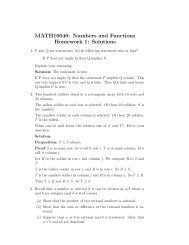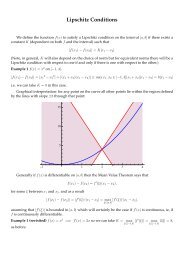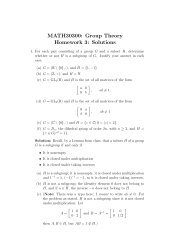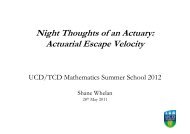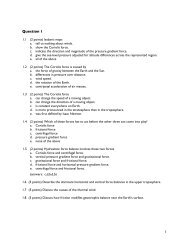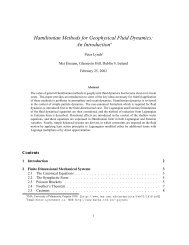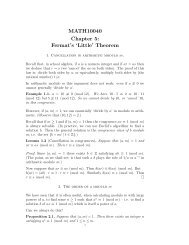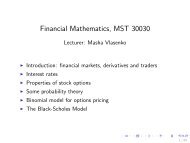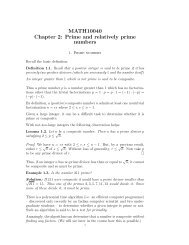Chapter 5. Mathematics in the time of Descartes and Fermat
Chapter 5. Mathematics in the time of Descartes and Fermat
Chapter 5. Mathematics in the time of Descartes and Fermat
You also want an ePaper? Increase the reach of your titles
YUMPU automatically turns print PDFs into web optimized ePapers that Google loves.
(1777-1855) is known as one <strong>of</strong> <strong>the</strong> greatest ma<strong>the</strong>maticians <strong>of</strong> all <strong>time</strong>. His early famerests on his book Disquisitiones arithmeticae, published <strong>in</strong> 1801 when he was just 24. Thebook conta<strong>in</strong>s all <strong>the</strong> work on number <strong>the</strong>ory that he had done up to that <strong>time</strong>. It <strong>in</strong>cludes<strong>the</strong> def<strong>in</strong>itive result on <strong>the</strong> construction <strong>of</strong> regular polygons us<strong>in</strong>g ruler <strong>and</strong> compass alone.It had been known s<strong>in</strong>ce <strong>the</strong> <strong>time</strong> <strong>of</strong> Euclid <strong>and</strong> earlier that we can construct a regular(equilateral) triangle, a regular pentagon, a regular hexagon, <strong>and</strong> any regular polygonhav<strong>in</strong>g 2 n sides, us<strong>in</strong>g a ruler <strong>and</strong> compass alone. No fur<strong>the</strong>r constructions <strong>of</strong> such figureswere known. Us<strong>in</strong>g his work on <strong>the</strong> roots <strong>of</strong> <strong>the</strong> polynomial x n −1 (which are <strong>of</strong> course <strong>the</strong>complex roots <strong>of</strong> unity cos(2kπ/n)+i s<strong>in</strong>(2kπ/n)), Gauss proved <strong>the</strong> follow<strong>in</strong>g fundamentalresult:• Let p be a prime number. A regular polygon <strong>of</strong> p sides is constructible by ruler <strong>and</strong>compass alone if <strong>and</strong> only if p is a <strong>Fermat</strong> prime. A regular polygon <strong>of</strong> n sides isconstructible by ruler <strong>and</strong> compass alone if <strong>and</strong> only if, <strong>in</strong> <strong>the</strong> prime factorization <strong>of</strong>n, we have n = 2 t p 1 p 2 · · · p r , where p 1 , . . . , p r are different <strong>Fermat</strong> primes.It is said that Gauss’s discovery <strong>of</strong> <strong>the</strong> construction by ruler <strong>and</strong> compass <strong>of</strong> <strong>the</strong> regular17-sided polygon <strong>in</strong> 1796, when he was only 18, was <strong>the</strong> crucial event that decided him onhis career as a ma<strong>the</strong>matician <strong>and</strong> not as a philologist. The actual construction is a littletechnical but Gauss’s work is considered to be <strong>the</strong> most orig<strong>in</strong>al addition to <strong>the</strong> study <strong>of</strong>Euclidian geometry for over two thous<strong>and</strong> years.His success <strong>in</strong> show<strong>in</strong>g <strong>the</strong> non-existence <strong>of</strong> non-trivial <strong>in</strong>tegral solutions to <strong>the</strong>seDiophant<strong>in</strong>e equations must have led <strong>Fermat</strong> to believe that <strong>the</strong> method <strong>of</strong> descent couldlikewise prove that <strong>the</strong>re are no non-zero <strong>in</strong>tegers x, y <strong>and</strong> z that satisfyx n + y n = z n ,whenever n is an <strong>in</strong>teger greater than 2. He certa<strong>in</strong>ly left a note <strong>in</strong> <strong>the</strong> marg<strong>in</strong> <strong>of</strong> his copy<strong>of</strong> <strong>the</strong> Arithmetica stat<strong>in</strong>g that he had found such a solution. Nobody was able to make<strong>the</strong> method <strong>of</strong> descent apply <strong>in</strong> <strong>the</strong> cases where n > 4, <strong>and</strong> we must presume that <strong>Fermat</strong>was wrong <strong>in</strong> his claim. In fact, attempts to verify <strong>the</strong> truth <strong>of</strong> <strong>Fermat</strong>’s Last Theorem(as <strong>the</strong> claim became known) led to <strong>the</strong> development <strong>of</strong> a vast generalization <strong>of</strong> arithmeticknown as algebraic number <strong>the</strong>ory, <strong>in</strong> which <strong>the</strong> <strong>the</strong>ory <strong>of</strong> primes <strong>and</strong> unique factorizationis carried over to certa<strong>in</strong> special types <strong>of</strong> complex number. Even this was not enough toprove <strong>Fermat</strong>’s Last Theorem <strong>in</strong> general, as <strong>the</strong> complete pro<strong>of</strong> by Andrew Wiles <strong>in</strong> 1995used techniques <strong>of</strong> algebraic geometry <strong>and</strong> modular form <strong>the</strong>ory.10




